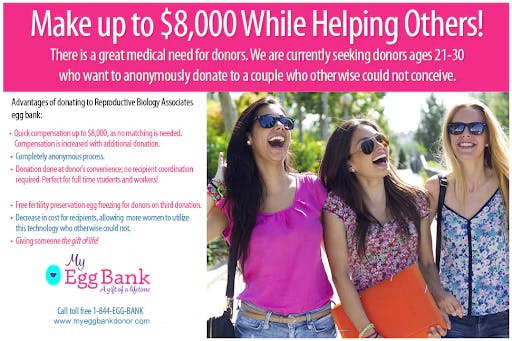An Ad In My College Paper Led Me To Investigate The Dark Side Of Egg Donation
I vividly remember the ad in the Harvard Crimson: “Egg donor wanted: $60,000 plus all medical expenses paid.”

It specified a lot about the potential donor (she had to be blonde, over 5’6”, an athlete, and preferably at least bilingual), but very little about what the process entailed. It was even pitched as a little altruistic, helping couples struggling with infertility to start families. Having just started starving grad student life, my curiosity was more than a little piqued. How bad could it really be?
Clicking on the ad sent me a screener, which asked for an intrusive amount of information: athletic history, extensive family medical history, SAT and GRE scores, and photos throughout childhood to prove I’d never been overweight. Even Harvard’s application hadn’t been so thorough.

Image Source: Business Insider
As they asked more and more about my background without specifying much about what the donation process might entail, I began to get a little spooked. I’d been a regular blood donor, and even that had come with a wealth of warnings. Before going further, I turned to other resources to learn about the medical implications of egg donation. What I found convinced me that no amount of financial compensation was worth the risk.
The egg donation market is absolutely booming. While many of its critics focus on the eugenic creepiness of specifying your future baby’s hair color or the middling success rates of IVF in general, there’s an even darker side for the donors themselves. Most egg donation companies target young women, especially those struggling with income, focusing heavily on the financial benefits rather than the medical and psychological risks involved for the donor.
The extraction process can also be a pretty brutal procedure.
How Egg Donation Works
The beginning stages of donation involve early tests like blood tests and a transvaginal ultrasound, as well as beginning the birth control pill. Implants like IUDs, as well as the depo shot, typically disqualify a donor from the process unless she has the implant removed. Following at least one cycle of hormonal birth control, more blood and in-clinic tests are administered. At this point, tests can still entirely disqualify a woman from the process and any compensation she might have received.
Since the donation process requires your body to release a greater number of eggs than it would during a normal cycle, donors need to take injections for about two weeks leading up to the extraction. These follicle-stimulating hormone (FSH) shots are self-administered into the lower abdomen, encouraging the ovaries to release 10-20 eggs instead of just one. In addition to common side effects like nausea, bloating, pain, and severe swelling of the abdomen, these injections can also lead to a condition called Ovarian Hyperstimulation Syndrome, or OHSS, a severe swelling of the ovaries that can lead to blood clots and even kidney failure. In one case, a 23-year-old woman died due to ovary enlargement, with the autopsy revealing severely enlarged ovaries and internal bleeding.
If the hormone injections are successful, egg retrieval then involves an in-clinic procedure wherein the donor is sedated, typically without general anesthesia. A catheter is then inserted through the vagina to suction out eggs from her ovarian follicles.
Long-Term Risks
Fertility clinics are catering to the customers paying hundreds of thousands of dollars for their services. This gives them little incentive to scare away potential donors by being too transparent about longer-term risks involved with egg donating. The lack of informed consent means that one in five egg donors doesn’t even know there are health risks involved in donating.
While most fertility clinics will say there aren’t any major “known” side effects of egg donation with the “evidence to date,” most of the medical field is still flying blind. Diane Tober, a professor at UCSF School of Nursing, says, “We don’t really know if there is a causal connection between undergoing controlled ovarian stimulation and deleterious outcomes,” and began a project specifically to investigate the negative outcomes on women’s health. She says that while the American Society for Reproductive Medicine recommends no more than six donation cycles, many clinics incentivize repeat donors, and it’s not unheard of for women to do more than three times the recommended amount. Some clinics also give women so many hormones they release as many as 80 eggs in a single cycle.

Image Source: We Are Egg Donors
For now, it’s safe to assume a primary cause of the lack of evidence for long-term risks is because “No one’s tracking the data,” according to Timothy R. B. Johnson, the longtime chair of the department of obstetrics and gynecology at the University of Michigan School of Medicine. He advocates for a national registry to better understand the long-term health of egg donors, saying, “There is a total lack of information about the long-term [effects].”
Many, including donors who develop stage 4 cancers following egg donation, speculate that the use of hormones contributes to estrogen-related cancers like colon, breast, ovarian, and endometrial.

Image Source: Pacific Fertility Center
Closing Thoughts: Altruism at a Cost
Behind these fertility clinics are women truly struggling to conceive and begin families, and their struggle should not be minimized or demonized. Still, the egg donation industry is taking advantage of the lack of informed consent for donors and playing to prospective donors' altruism and financial need to profit. If even tampons come with warnings for rare side effects, how are the “vast majority” of egg donation advertisements allowed to completely ignore the potentially fatal consequences for donors?
Love Evie? Sign up for our newsletter and get curated content weekly!